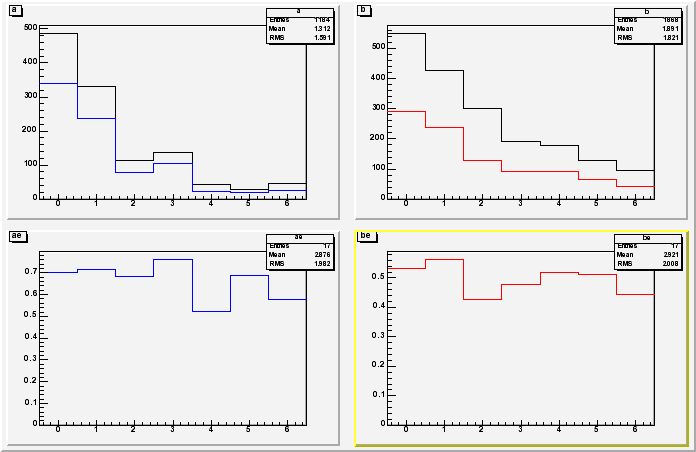Genya,
in the first plot the wch eff for events in L(blue) R(red). The bottom
panels give the ratio vs paddle number. This is run 9719 taken monday
eff = (# events in cut && qwl(r)==-1 && qwr(l) == + 1) / (# events in cut)
with some quick cuts on adc and tof coplanarity, as in ~/pro2004/analysis/zz.C
For e- in L sector the eff. for such a two track event is 70 %
For e- in R sector the efficiency is a little less than 50 %.
Both numbers are less than what I expected, but I stop here. Frankly,
even 50 % for two tracks is already 75% per sector. It can be better, but
is not final either. However it is clear that there will always be a
correction to be made. This is why I repeateadly mentioned that H2 unpol
is even more important thatn D2 unpol for our weekly routine (it gives
equivalent false asym info, but much more info on wch)
As you can see this result on the efficiency is in total agreement with
the observed ed rate vs montecarlo. Actually 0.70/0.5 = 1.4 and in the
second plot 6000/4400 = 1.36, which explains missing ed.
Now, the *blue* curve results in a luminosity of 1.3e31 at 100 mA. After
efficiency corrections, 1.86e31. This is a factor 2.7 away from 5e31.
We do not understand the target density. We simply can't make it 5.0e31.
I agree that there is wch/recon efficiency correction to be made, but even
with your wch efficiency of "40 to 60 %" we are talking of 1.3/0.5 = 2.6,
which is still a factor of 2 away from 5.0
> Calibrated by data from unpol runs, the target flux F=3*10**16 at/sec,
> total thickness in the area +- 2 cm from the center is about t=8*10**13
> at/cm**2, and the luminosity at 100 mA is about 5*10**31.
So what happened to the *trigger* studies ? I am relieved that you find
that we don't lose events in the trigger, including 2nd level trigger.
Of course now we can just say that there is 75% INefficiency built in at
the discriminator but that's just digging in forever. My personal take: we
have to find other ways or do other studies to understand the ABS intensity
instead of presenting it as a dogma. I am more than interested in trying
what has been demonstrated in amsterdam.
--------------------
About having the tracking program wrongly assigning charge = 0 to
candidate electron events. I think this is not the case and please see
last attachemnt. With some very rough cuts ( trig==1, electron in paddle <
7 , proton in paddle > 8) *and requiring a cerenkov, 97 % of these events
have the right charge, q=-1.
Since the cerenkov does not influence the tracking I think statements
such as "many (electrons) events had charge = 0" (or similar) are not
supported by the data.
-- ________________________________________________________________________________ Tancredi Botto, phone: +1-617-253-9204 mobile: +1-978-490-4124 research scientist MIT/Bates, 21 Manning Av Middleton MA, 01949 ^^^^^^^^^^^^^^^^^^^^^^^^^^^^^^^^^^^^^^^^^^^^^^^^^^^^^^^^^^^^^^^^^^^^^^^^^^^^^^^^


This archive was generated by hypermail 2.1.2 : Mon Feb 24 2014 - 14:07:31 EST